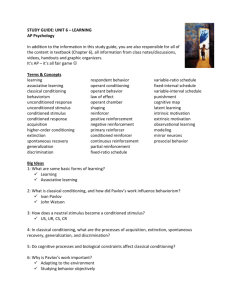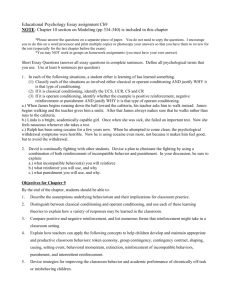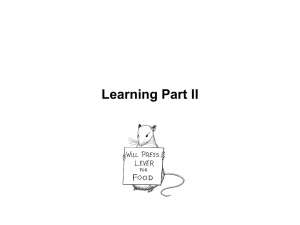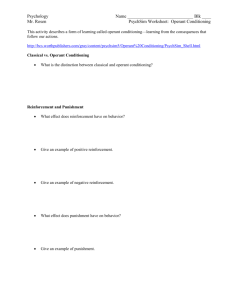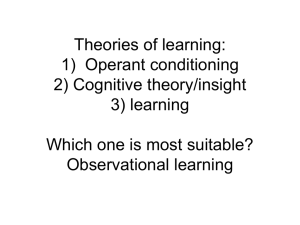Introduction to Psychology
advertisement
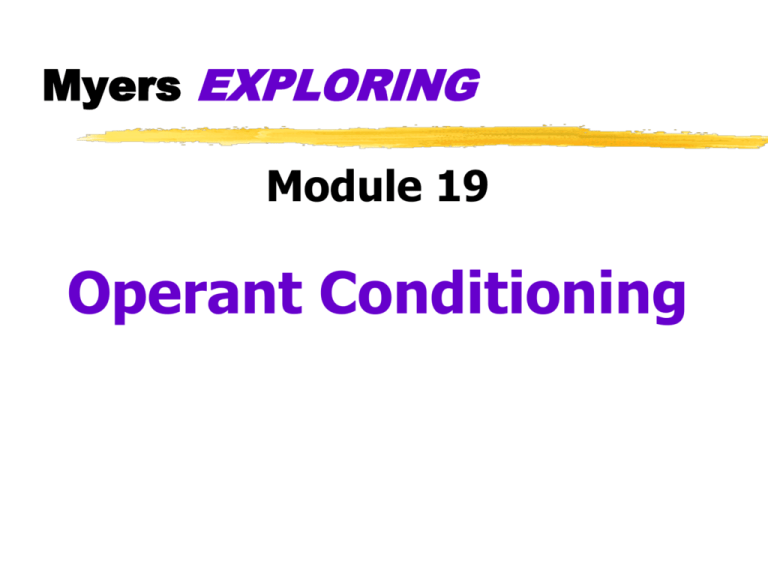
Myers EXPLORING Module 19 Operant Conditioning Operant vs Classical Conditioning Operant Conditioning Operant Conditioning type of learning in which behavior is strengthened if followed by reinforcement or diminished if followed by punishment Law of Effect Thorndike’s principle that behaviors followed by favorable consequences become more likely, and behaviors followed by unfavorable consequences become less likely Operant Conditioning Respondent Behavior occurs as an automatic response to stimulus behavior learned through classical conditioning Operant Behavior operates (acts) on environment produces consequences Operant Conditioning B.F. Skinner (1904-1990) elaborated Thorndike’s Law of Effect developed behavioral technology Operant Chamber Skinner Box chamber with a bar or key that an animal manipulates to obtain a food or water reinforcer contains devices to record responses Operant Conditioning Reinforcer any event that strengthens the behavior it follows Shaping operant conditioning procedure in which reinforcers guide behavior toward closer approximations of a desired goal Superstitious Behavior A behavior that is unrelated to the behavior being conditioned but has inadvertently been reinforced often enough that it becomes fixed in the subject's mind as necessary in order to receive reinforcement. Operant Conditioning Principles of Reinforcement Reinforcer any event that strengthens the behavior it follows Primary Reinforcer innately reinforcing stimulus i.e., satisfies a biological need Conditioned Reinforcer stimulus that gains its reinforcing power through its association with primary reinforcer secondary reinforcer Learning Links Einstein the bird Skidboot B.F. Skinner interview CD#1, Learning,#9 Chain Behavior An individual response linking two or more individual behaviors in a specific order, elicited by a common discriminative stimulus (SD), or other stimulus. Each response acts as a conditioned reinforcer for the previous response and also provides the stimulus for the next behavior in the chain. The behavior is typically bridged at the end of the chain; the bridge serves as a conditioned reinforcer for the entire chain. Schedules of Reinforcement Continuous Reinforcement reinforcing the desired response each time it occurs Partial (Intermittent) Reinforcement reinforcing a response only part of the time results in slower acquisition greater resistance to extinction Schedules of Reinforcement Fixed Ratio (FR) Schedule reinforces a response only after a specified number of responses faster you respond the more rewards you get different ratios very high rate of responding like piecework pay Schedules of Reinforcement Variable Ratio (VR) reinforces a response after an unpredictable number of responses average ratios like gambling, fishing very hard to extinguish because of unpredictability Schedules of Reinforcement Fixed Interval (FI) reinforces a response only after a specified time has elapsed response occurs more frequently as the anticipated time for reward draws near Schedules of Reinforcement Variable Interval (VI) reinforces a response at unpredictable time intervals produces slow steady responding like pop quiz Schedules of Reinforcement Number of responses 1000 Fixed Ratio Variable Ratio Fixed Interval 750 Rapid responding near time for reinforcement 500 Variable Interval 250 Steady responding 0 10 20 30 40 50 Time (minutes) 60 70 80 Punishment Punishment aversive event that decreases the behavior that it follows powerful controller of unwanted behavior Punishment Cognition and Operant Conditioning Cognitive Map mental representation of the layout of one’s environment Example: after exploring a maze, rats act as if they have learned a cognitive map of it CD #1, #10 Cognition and Operant Conditioning Latent Learning learning that occurs, but is not apparent until there is an incentive to demonstrate it Latent Learning For example, if you are in a car going to school with a friend every day, but your friend is driving all the time, you may learn the way to get to school, but have no reason to demonstrate this knowledge. However, when you friend gets sick one day and you have to drive yourself for the first time, if you can get to school following the same route you would go if your friend was driving, then you have demonstrated latent learning." A reason for behaving Motivation Intrinsic Motivation desire to perform a behavior for its own sake and to be effective Extrinsic Motivation desire to perform a behavior due to promised rewards or threats of punishments



